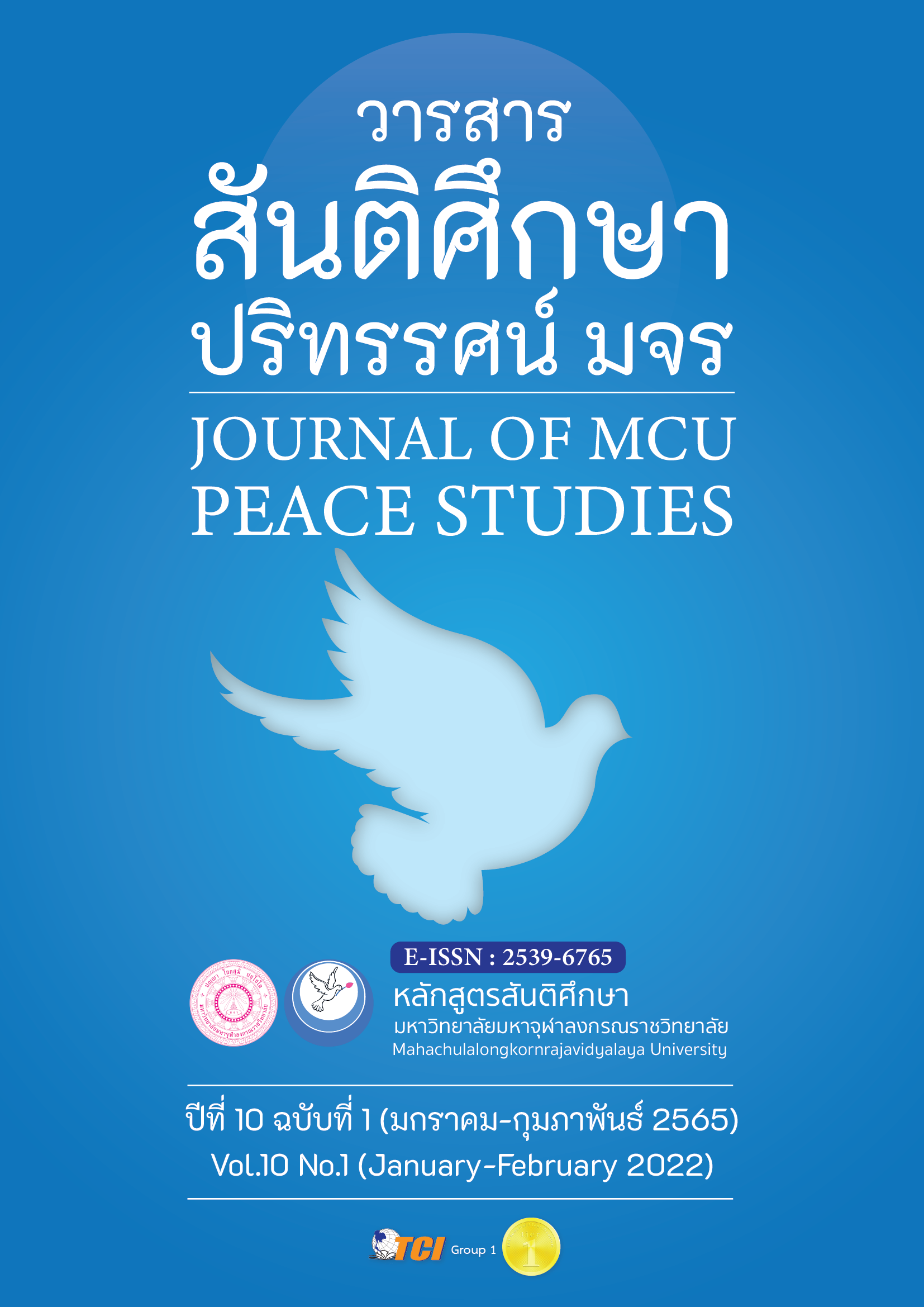แนวทางการส่งเสริมการอนุรักษ์วัฒนธรรมไฉ่เตี้ยวกวางสีในโรงเรียน
Main Article Content
บทคัดย่อ
บทความวิจัยมีวัตถุประสงค์ 1) เพื่อศึกษาสภาพปัจจุบันของการจัดการเรียนการสอนวัฒนธรรม
ไฉ่เตี้ยวกวางสีในโรงเรียน และ 2) เพื่อเสนอแนวทางการส่งเสริมการอนุรักษ์วัฒนธรรมไฉ่เตี้ยวกวางสี
ในโรงเรียน การวิจัยนี้เป็นแบบการวิจัยเชิงคุณภาพ โดยการศึกษาเอกสาร การสัมภาษณ์ และการสนทนากลุ่ม
มีผู้ให้ข้อมูลสำคัญ 30 คน ผู้ทรงคุณวุฒิจำนวน 20 คนครูผู้สอนไฉ่เตี้ยวในโรงเรียนระดับมัธยมศึกษาหนานหนิง เมืองหนานหนิงของมณฑลกวางสี จำนวน 5 คน ศิลปินพื้นบ้านไฉ่เตี้ยวและ นักแสดงไฉ่เตี้ยวของคณะละคร
ไฉ่เตี้ยวมืออาชีพหนานหนิง จำนวน 5 คน
ผลการวิจัยพบว่า 1) สภาพปัจจุบันของการจัดการเรียนการสอนวัฒนธรรมไฉ่เตี้ยวกวางสีในโรงเรียน โรงเรียนไม่สนับสนุนไฉ่เตี้ยวของกวางสี หลักสูตรมีเนื้อหาที่มีอยู่ในตำราเรียนเนื้อหาของไฉ่เตี้ยวกวางสีมีจำกัด โรงเรียนส่วนใหญ่ไม่มีหลักสูตรเสริม และกิจกรรมที่เกี่ยวข้องกับไฉ่เตี้ยวกวางสีไม่เพียงพอ สภาพแวดล้อมการจัดการเรียนการสอนไม่เอื้ออำนวย ทักษะและวิธีการสอนของครูควรได้รับการเสริมสร้างและปรับให้เหมาะสมยิ่งขึ้น ในการพัฒนาคุณภาพครูจำเป็นต้องได้รับปรับปรุงให้ดียิ่งขึ้น 2) แนวทางการส่งเสริมการอนุรักษ์วัฒนธรรมไฉ่เตี้ยวกวางสีในโรงเรียน มี 5 แนวทาง ได้แก่ 1)ด้านการบริหารโรงเรียน 2)ด้านการจัดการเรียนการสอน 3)ด้านการจัดหลักสูตรสอนเสริม 4)ด้านการจัดสภาพสิ่งแวดล้อม 5)ด้านการพัฒนาสมรรถภาพการจัดการเรียนการสอนของครูผู้สอน
Article Details

อนุญาตภายใต้เงื่อนไข Creative Commons Attribution-NonCommercial-NoDerivatives 4.0 International License.
ทัศนะและความคิดเห็นที่ปรากฏในบทความในวารสาร ถือเป็นความรับผิดชอบของผู้เขียนบทความนั้น และไม่ถือเป็นทัศนะและความรับผิดชอบของกองบรรณาธิการ ยินยอมว่าบทความเป็นลิขสิทธิ์ของวารสาร
เอกสารอ้างอิง
Bai Yue. (2018). Research on Traditional Chinese Opera Entering High School Music ClassroomTaking Two High Schools in Guilin City as Examples. (Master's Thesis). Guangxi Normal University. Guilin.
Guizhengfa. (2021). Notice of the People's Government of Guangxi Zhuang Autonomous Region on Printing and Distributing the "14th Five-Year Plan" for the Development of Education in Guangxi. Retrieved January 28, 2022, from http://www.gxzf.gov.cn/zfwj/zxwj/t10619884.shtml.
Huang, Fen. (2017). Thinking on the development reality and trend of Guangxi cai diao drama. Art Review, 6, 42-44.
Jiao, G., & Jiao, M. (2022). Announcement on the implementation of the evaluation of the Ethnic Culture Education Demonstration School in the Autonomous Region Guangxi Zhuang. Retrieved January 28, 2022, from http://wlt.gxzf.gov.cn/zwgk/tzgg/t11236653.shtml.
Lijuan, F., & Yao, Q. (2019). A Study on the Tourism Development of Intangible Cultural Heritage Taking Guilin Caidiao Opera as an Example. Journal of Guilin Normal College, 5, 13-16.
Lin Jie. (2018). The school-Based Curriculum Development in Primary School from The Perspective of Regional Culture Take the Guangxi Caidiao as an Example. Journal of Guangxi Nomal University, 3, 60-68.
Li Fengyun. (2018). spread of Guangxi local opera art in vocational colleges takes Zhuang cai diao as an example. Jouanal of Guangxi Education, 31, 65-68.
Minlan, Zhao. (2011). Study of Rhetoric in Guangxi Caidiao Opera. Journal of Hechi University, 4, 60-66.
Ning-ning, Yang. (2014). Dilemma between Primitive and Fashionable Elements from Caidiao Opera Sanjie Liu to Opera of Impression on Sanjie Liu. Journal of Minzu University of China (Philosophy and Social Sciences Edition), 4, 124-130.
Pang, R., & Huang, H. Y. (2009). Study on Status and Survival Strategies of Caitiao Guilin, Guangxi. Journal of Xi'an University of Arts and Science (Social Sciences Edition), 6, 59-63.
Que Zhen. (2015). Reflections on the Protection of Guangxi Local Opera. Southern Literature, 2, 155-159.
Shen Ting. (2017). Study on the historical evolution and inheritance strategy of Guangxi cai diao. The Voice of the Yellow River, 23, 150-150.
Shen Ting. (2018). The Practical significance of Guangxi cai diao in Vocal Teaching of Guangxi High Teachers. Journal of Northern Music, 10, 164-165.
Tang Wensheng. (2017). Research on the inheritance status and development strategy of Yizhou cai diao in Guangxi. Guangxi Social Sciences, 2, 31-34.
Wanchaem, N., Saengsook, N., & Saengsook., N. (2016). Knowledge Management on the Central Region’s Thai Folk Song Cultural Conservation: A Case Study of The E –Saew Song,Suphanburi Province (Research Report). Bangkok: Ramkhamhaeng University.
Wang Li. (2021). Practical strategy of integrating cai diao into Guangxi higher vocational music teaching in northwest Guangxi. Journal of JIAOYU GUANCHA, 10, 102-104.
Wei, C., Zhenhuan, Z., & Qiaoyan, Z. (2008). The Research into the Traditional Opera of the Intangible Cultural Heritage in the Minor Nationalities Areas take the Guilin Cai Diao as an example [J]. Journal of Guilin Normal College, 3, 22-31.
Wenjin, S. (2014). Inheritance and protection of film art of the intangible cultural heritage of Guangxi Caidiao Take the film of" Liu Sanjie" in the 1978 as an example. Journal of Jiamusi Education Institute, 2, 132-133.
Xiankai, Li. (2008). Primary Research on Reasons of Difficult Survival Situation of Local Drama Taking the" Cai Diao" as Research Object. Journal of Hebei Polytechnic College, 8(2), 102-104.
Xiaorong, W. (2010). The Review on the Studies of Educational Anthropology in China [J]. Ethno-National Studies, 2, 89-110.
Xie Chunyu. (2017). takes Guangxi cai diao adjustment as an example. Journal of A Comparative Study of Cultural Innovation, 22, 31-32.
Yanhong, Tang. (2009). On Folklore in Cai Diao Opera of Guangxi. Journal of Liuzhou Teachers College, 24(3), 22-24.
Yingcai, M. (2010). Read and Explain" Cai Diao" from the View of Cultural Anthropology. Journal of Pingxiang College, 27(1), 70-72.
Yingwen, X., & Mozgot, S. A. (2020). Liu Sanjie: The Image of a Woman in Tthe Traditional Folk Drama of Guangxi" Cai Diao. BECTHNK, 100.
Zhang Yinghua, & Xie Jiaxing. (2012). An analysis of the context related to music education of contemporary ethnic minorities in my country. Huang Zhong: Journal of Wuhan Conservatory of Music, 1, 126-133.
Zhen, Que. (2012). On the Relationship between Guangxi Cai Diao's Development and Psychological Demand. Journal of Guangxi Normal University (Philosophy and Social Sciences Edition), 48(3), 65-70.


